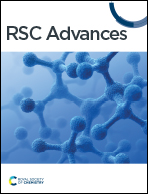Experimental study on CO2 capture by MEA/n-butanol/H2O phase change absorbent†
Abstract
Monoethanolamines (MEAs) are widely used for CO2 capture, but their regeneration energy consumption is very high. CO2 Phase change absorbents (CPCAs) can be converted into CO2-rich and CO2-lean phases after absorbing CO2, and the regeneration energy consumption can be reduced because only the CO2-rich phase is thermally desorbed. In this paper, a novel CPCA with the composition “MEA/n-butanol/H2O (MNBH)” is proposed. Compared with the reported MEA phase change absorbent, the MNBH absorbent has higher CO2 absorption capacity, smaller absorbent viscosity and CO2-rich phase volume. The MNBH absorbent has the highest CO2 absorption capacity of 2.5227 mol CO2 per mol amine at a mass ratio of 3 : 4 : 3. The CO2 desorption efficiency reaches 89.96% at 120 °C, and the CO2 regeneration energy consumption is 2.6 GJ tCO2−1, which is about 35% lower than that of the 30 wt% MEA absorbent. When the mass ratio of MNBH absorbent was 3 : 6 : 1, the CO2 recycling capacity was 4.1918 mol CO2 L−1, which is 76% higher than that of the conventional 30 wt% MEA absorbent. The phase change absorbent developed in this paper can reduce the desorbent volume by about 50% and has good absorption performance for CO2 in flue gas.



 Please wait while we load your content...
Please wait while we load your content...